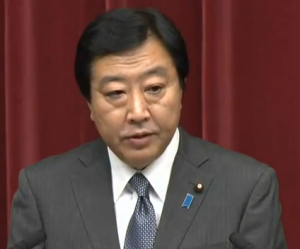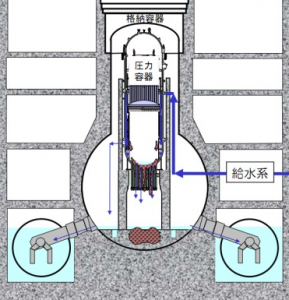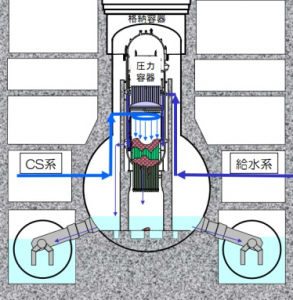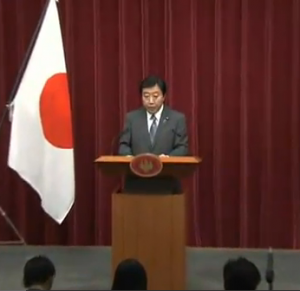During a television address on Friday, Japan's Prime Minister Yoshihiko Noda said the Fukushima nuclear reactors have been brought to a state of cold shutdown. Speaking from his Tokyo office (video in Japanese, above), Noda said that the government and Tokyo Electric Power Co. had managed to contain the nuclear crisis. "A stable condition has been achieved, and we can consider the accident itself contained," Noda said. (short video recap of crisis from nature.com) On Saturday, Japanese newspapers quickly dismissed the Prime Minister's cold shutdown declaration as meaning only "first aid" had been completed, according to Japan Today.

"'The state of cold shutdown' is easy on the ears but the actual state does not allow optimism," the liberal Asahi Shimbun said. "It is as if a patient came out of a life-or-death condition but remained hospitalized," it said, warning fears remain that problems at the power station could worsen again. "Molten fuel is still in reactors and its cooling depends on tentatively-built facilities. There is no change to the situation in which the normal cooling systems do not work." The conservative Yomiuri Shimbun said Noda's declaration meant "nothing more than the first aid measures are over...The real battle starts from here," it said, noting that melted fuel in the reactors and contaminated water used for cooling still had to be disposed of.
Many nuclear engineering experts said that the strict definition of cold shutdown is for an intact reactor. In summary, no one knows how to define it, in regulatory terms, for reactors as badly damaged as the units at Fukushima. The New York Times cited a skeptical expert: "Cold shutdown is a term that has been trotted out to give the impression we are reaching some sort of closure," said Hiroaki Koide, at the Research Reactor Institute at Kyoto University and a prominent critic of nuclear power. "We still face a long battle of epic proportions, and by the time it is really over, most of us will be long dead." The government says dismantling the plant will take at least four decades.
The government's evolving explanations
These reactions could be expected, coming so shortly after TEPCO's other stop-gap attempts to calm the nation's nerves. The most unsettling showed a government minister drinking a glass of contaminated water from the reactors to prove it's safety for skeptical reporters. The Guardian newspaper reported from the press conference:
Yasuhiro Sonoda, an MP in the governing Democratic party of Japan (DPJ), was visibly nervous as his lips met a glass of water collected from inside two reactor buildings at the Fukushima Daiichi nuclear power plant. Sonoda's hands shook as he half-filled the glass from a plastic bottle, before polishing off the water in two swift gulps. He briefly held the glass up to the cameras, as if to prove that no sleight of hand had been involved.
There were also recently revised computer simulations of the meltdown. According to the IEEE blog, TEPCO released new CGI images that showed that the meltdown was much worse than the company had previously announced. It appeared that nearly all the nuclear fuel in reactor 1 melted through the first line of defense, the steel reactor vessel, and into in the next protective layer. (The fuel sludge is the brown blob.)

The breached primary containment vessel (see a larger version), a steel structure in the shape of an upside-down light bulb, has concrete at the bottom; TEPCO's analysis has the fuel melting through 70 centimeters of that concrete, still leaving 190 centimeters of concrete between the melt and the steel boundary of the primary containment vessel. Fortunately, the secondary containment area has 760 centimeters of concrete standing between the primary containment and the earth below.

At reactors 2 and 3, the simulation projected that smaller amounts of fuel melted holes in the pressure vessels and merely dropped down to the concrete floor in the primary containment vessel (a larger image). The latest analysis replaces one from the May account for the emergence of new information that contradicted its earlier predictions. Unfortunately, this was still only a simulation that may still underestimate the reactor problem. With the intense radiation around the reactors, there's been no way to measure the actual location of the fuel. TEPCO's newest findings represent a troubling damage scenario-creep, which has cratered its already low reputation among the Japanese--an American analogy: cable company arrogance multiplied by CIA opaqueness. Right after the quake and tsunami hit, with reactor explosions deluging global media (observed with BBC understatement), the company insisted that there was no breach at any of the three most-damaged reactors; as the partial meltdown continued, with global sensors and researchers picking up increased radiation levels, TEPCO declared that there might have been a breach, but that most of the nuclear fuel had remained within the containment vessels. By now, after this latest simulation, traumatized Japanese citizens are primed for Godzilla to rear up and knock down a few Tokyo neighborhoods.
Noda's immediate and future concerns
Dan Yurman, a consultant to the global nuclear industry in social media, writes at his blog Idaho Samizdat: There is wide public distrust of the government and TEPCO, which is a huge cultural shift for Japanese society...

Noda's government and his successors will have to show progress on cleanup and ensure that no new radiation comes from the site. One positive sign of progress is a temporary shell has been completed covering reactor 1 which will help contain any future radiation releases. Yurman continues: The estimate of the 30 to 40 year decommissioning keeps growing. The latest are in the range of $50-60 billion. But the immediate threat is that makeshift cooling systems could break down, leak, or worse, if an after-quake hits.


